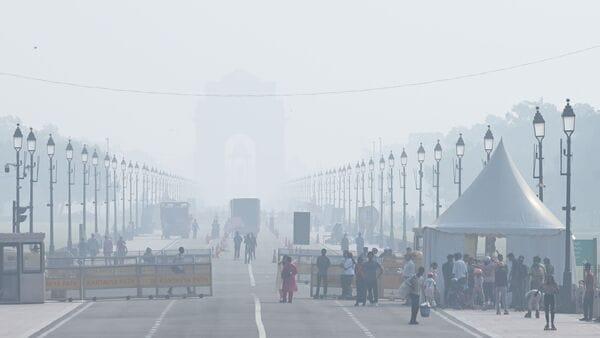
Delhi Air Quality To Sink To 'Very Poor' Category Mon-Wed Amid Stubble Burning
Delhi's air quality index (AQI) was 277 on Sunday, against 278 the day before, according to the Central Pollution Control Board (CPCB).
Air quality standards are slotted into six AQI categories-good (0-50), satisfactory (51-100), moderate (101-200), poor (201-300), very poor (301-400) and severe (401-500).
SAFAR attributes the deterioration to unfavourable meterological conditions due to dispersion of pollutants as calm winds prevail during night.
Also read: India plans stricter quality standards to tackle air pollution“Additional emissions from sources such as stubble/waste burning are likely to deteriorate air quality significantly,” it added in its latest bulletin on Sunday.
Stubble burningAs many as 3,376 fire and stubble burning incidents were reported between 15 September and 19 October in Punjab, Haryana, Uttar Pradesh, Delhi, Rajasthan and Madhya Pradesh. This compares with 3,134 incidents reported during the same period last year, according to a Sunday bulletin from CREAMS-Indian Agricultural Research Institute, which monitors satellite data on stubble, or crop residue, burning.
Stubble burning is the practice of igniting leftover straw and stubble after harvesting crops to prepare the fields for the winter sowing season.
Factors that contribute to the air pollutionWhile several factors contribute to the air pollution in the national capital, stubble burning in Delhi's neighboring states such as Punjab, Haryana and Uttar Pradesh is considered to be a major cause behind it.
However, official data from Pune's Indian Institute of Tropical Meteorology (IITM) revealed that stubble burning contributed a little over 1.3% to Delhi's air quality on 19 October, and the burning of crop residue is likely to contribute 2.3% and 2.4% to bad air quality in Delhi on Sunday and Monday, respectively.
These percentages, though seemingly modest, highlight a worrying upward trend, especially considering that stubble burning's contribution had peaked at 1.2% on 15 October and had otherwise remained below 1% earlier in the month.
Also read: Govt proposes to amend pollution control norms, impacting polluting industriesThe Supreme Court pulled up the Punjab and Haryana governments on Wednesday for their failure to take effective action against stubble burning, which contributes to worsening air pollution in Delhi and nearby regions during the winter months.
Notably, vehicular emissions within Delhi remain the most significant contributor, accounting for around 14.2% on 18 October, which dropped to 11.2% on Saturday. Projections indicate it could decrease slightly further to 10.5% during subsequent days.
IITM said that a significant degree of pollution, ranging between 32% and 44%, is caused by sources not yet pinpointed, emphasising the complexity of effectively addressing Delhi's air quality challenges.
This 'unidentified' variable remains a critical area for research, as the city grapples with escalating pollution.
As a preventative measure, the Delhi Pollution Control Committee has already implemented a complete ban on the manufacturing, storage, sale, and use of all types of firecrackers in the national capital until 1 January. Similarly, authorities in Punjab have imposed a ban on the bursting of crackers, and in Haryana's Gurugram, green crackers will be allowed for Diwali celebrations.
Also read: Why Delhi's air quality remains in the red despite a fall in stubble burning The Commission for Air Quality Management has already activated Stage-I of the Graded Response Action Plan (GRAP), a series of measures to combat air pollution in the National Capital Region. The government is also considering cloud seeding as an emergency measure to reduce pollution. Legal Disclaimer:
MENAFN provides the
information “as is” without warranty of any kind. We do not accept
any responsibility or liability for the accuracy, content, images,
videos, licenses, completeness, legality, or reliability of the information
contained in this article. If you have any complaints or copyright
issues related to this article, kindly contact the provider above.


















Comments
No comment